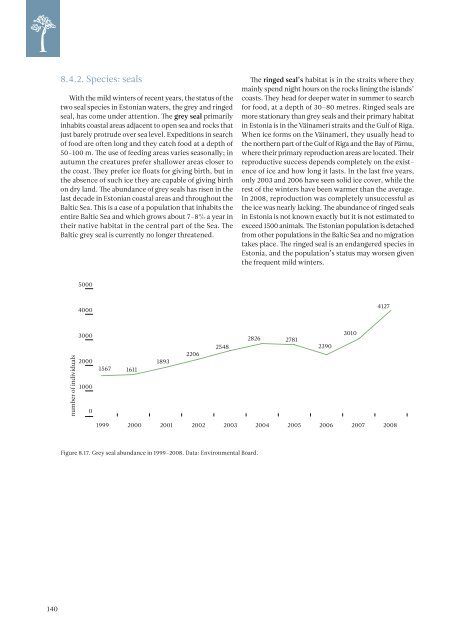ESTONIAN ENVIRONMENTAL REVIEW 2009
ESTONIAN ENVIRONMENTAL REVIEW 2009
ESTONIAN ENVIRONMENTAL REVIEW 2009
Create successful ePaper yourself
Turn your PDF publications into a flip-book with our unique Google optimized e-Paper software.
8.4.2. Species: seals<br />
With the mild winters of recent years, the status of the<br />
two seal species in Estonian waters, the grey and ringed<br />
seal, has come under attention. The grey seal primarily<br />
inhabits coastal areas adjacent to open sea and rocks that<br />
just barely protrude over sea level. Expeditions in search<br />
of food are often long and they catch food at a depth of<br />
50–100 m. The use of feeding areas varies seasonally; in<br />
autumn the creatures prefer shallower areas closer to<br />
the coast. They prefer ice floats for giving birth, but in<br />
the absence of such ice they are capable of giving birth<br />
on dry land. The abundance of grey seals has risen in the<br />
last decade in Estonian coastal areas and throughout the<br />
Baltic Sea. This is a case of a population that inhabits the<br />
entire Baltic Sea and which grows about 7–8% a year in<br />
their native habitat in the central part of the Sea. The<br />
Baltic grey seal is currently no longer threatened.<br />
The ringed seal’s habitat is in the straits where they<br />
mainly spend night hours on the rocks lining the islands’<br />
coasts. They head for deeper water in summer to search<br />
for food, at a depth of 30–80 metres. Ringed seals are<br />
more stationary than grey seals and their primary habitat<br />
in Estonia is in the Väinameri straits and the Gulf of Riga.<br />
When ice forms on the Väinameri, they usually head to<br />
the northern part of the Gulf of Riga and the Bay of Pärnu,<br />
where their primary reproduction areas are located. Their<br />
reproductive success depends completely on the existence<br />
of ice and how long it lasts. In the last five years,<br />
only 2003 and 2006 have seen solid ice cover, while the<br />
rest of the winters have been warmer than the average.<br />
In 2008, reproduction was completely unsuccessful as<br />
the ice was nearly lacking. The abundance of ringed seals<br />
in Estonia is not known exactly but it is not estimated to<br />
exceed 1500 animals. The Estonian population is detached<br />
from other populations in the Baltic Sea and no migration<br />
takes place. The ringed seal is an endangered species in<br />
Estonia, and the population’s status may worsen given<br />
the frequent mild winters.<br />
5000<br />
4000<br />
4127<br />
number of individuals<br />
3000<br />
2000<br />
1000<br />
0<br />
1567<br />
1611<br />
1893<br />
2206<br />
2548<br />
2826<br />
2781<br />
2390<br />
3010<br />
1999 2000 2001 2002 2003 2004 2005 2006 2007 2008<br />
Figure 8.17. Grey seal abundance in 1999–2008. Data: Environmental Board.<br />
hüllhüljes<br />
140

















